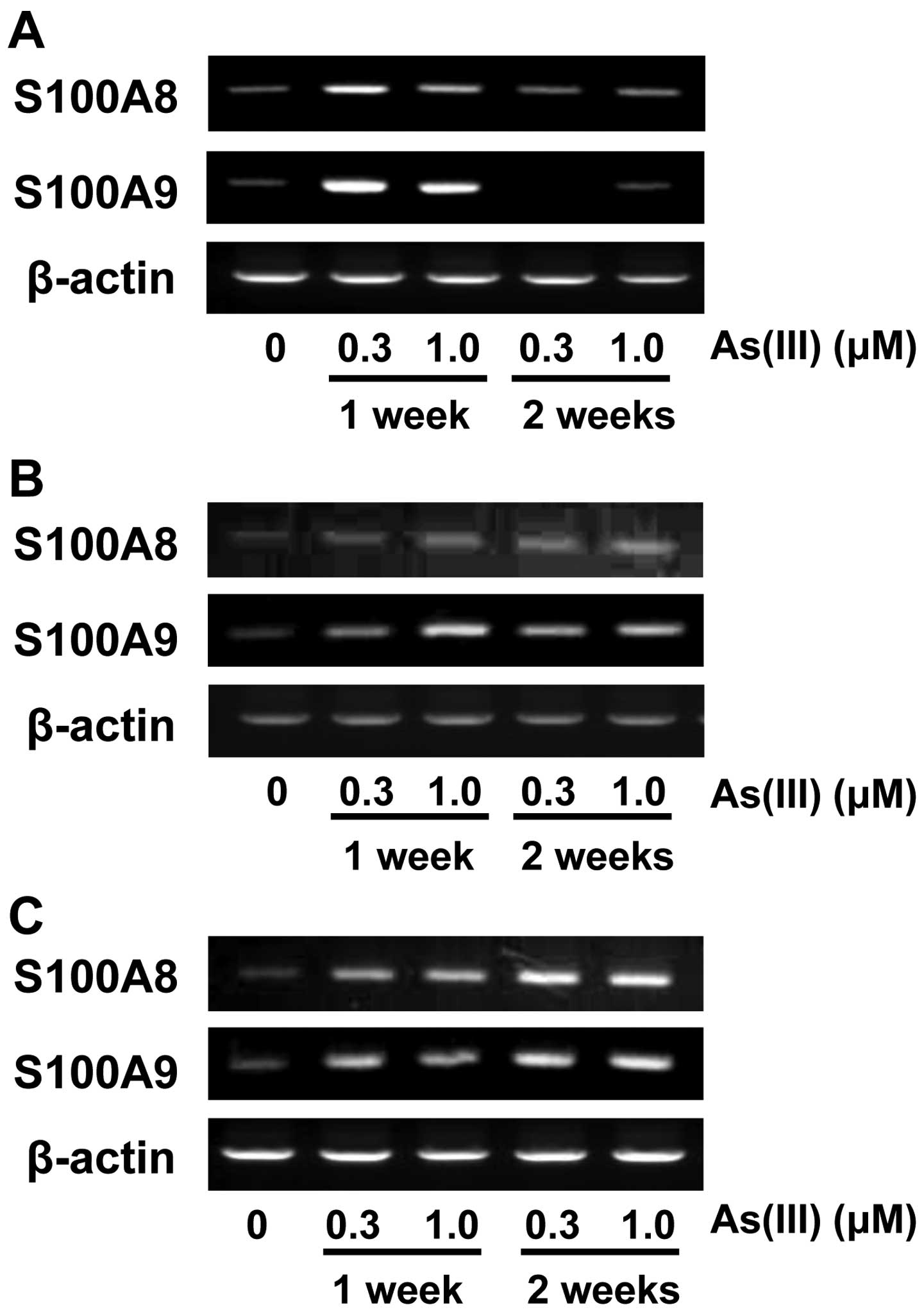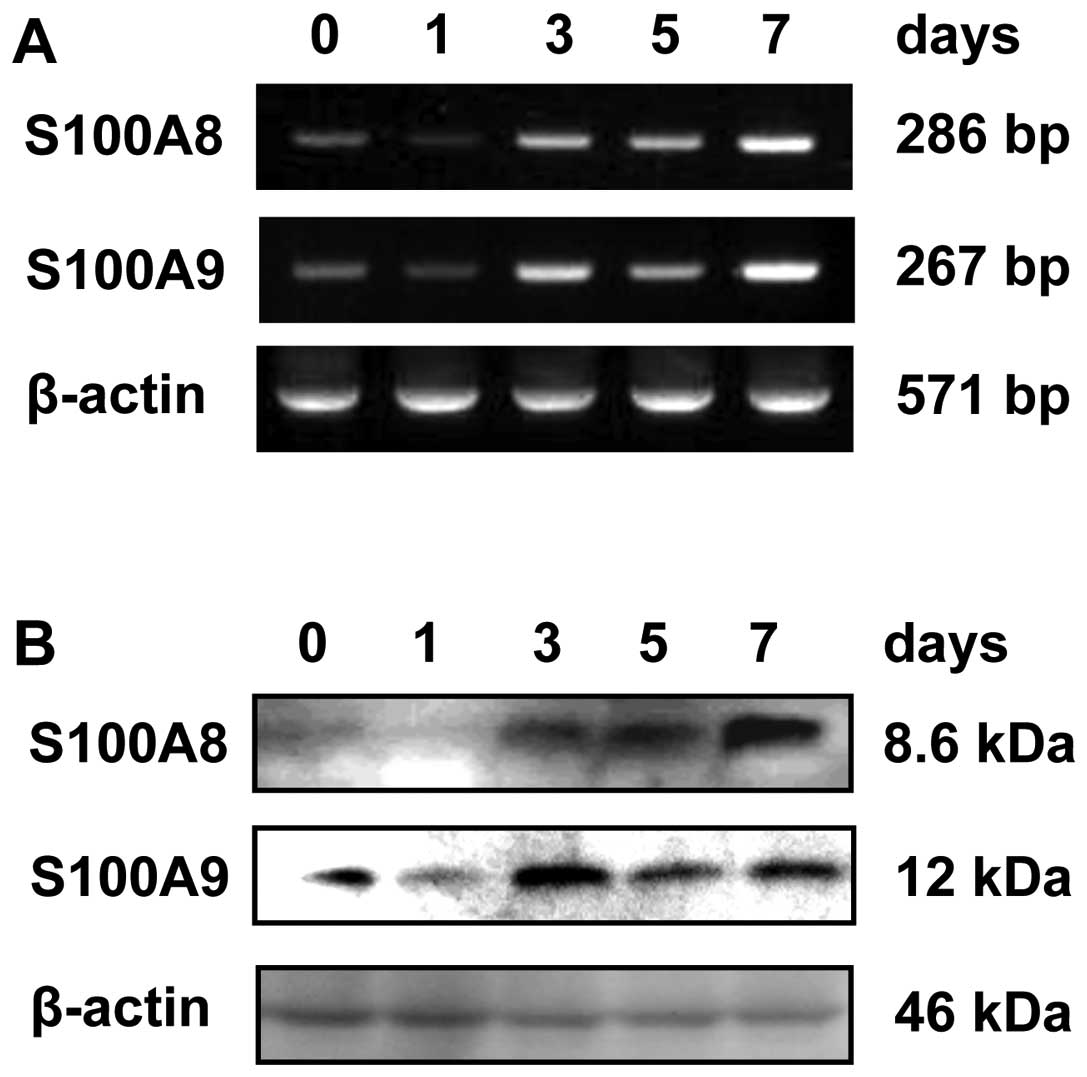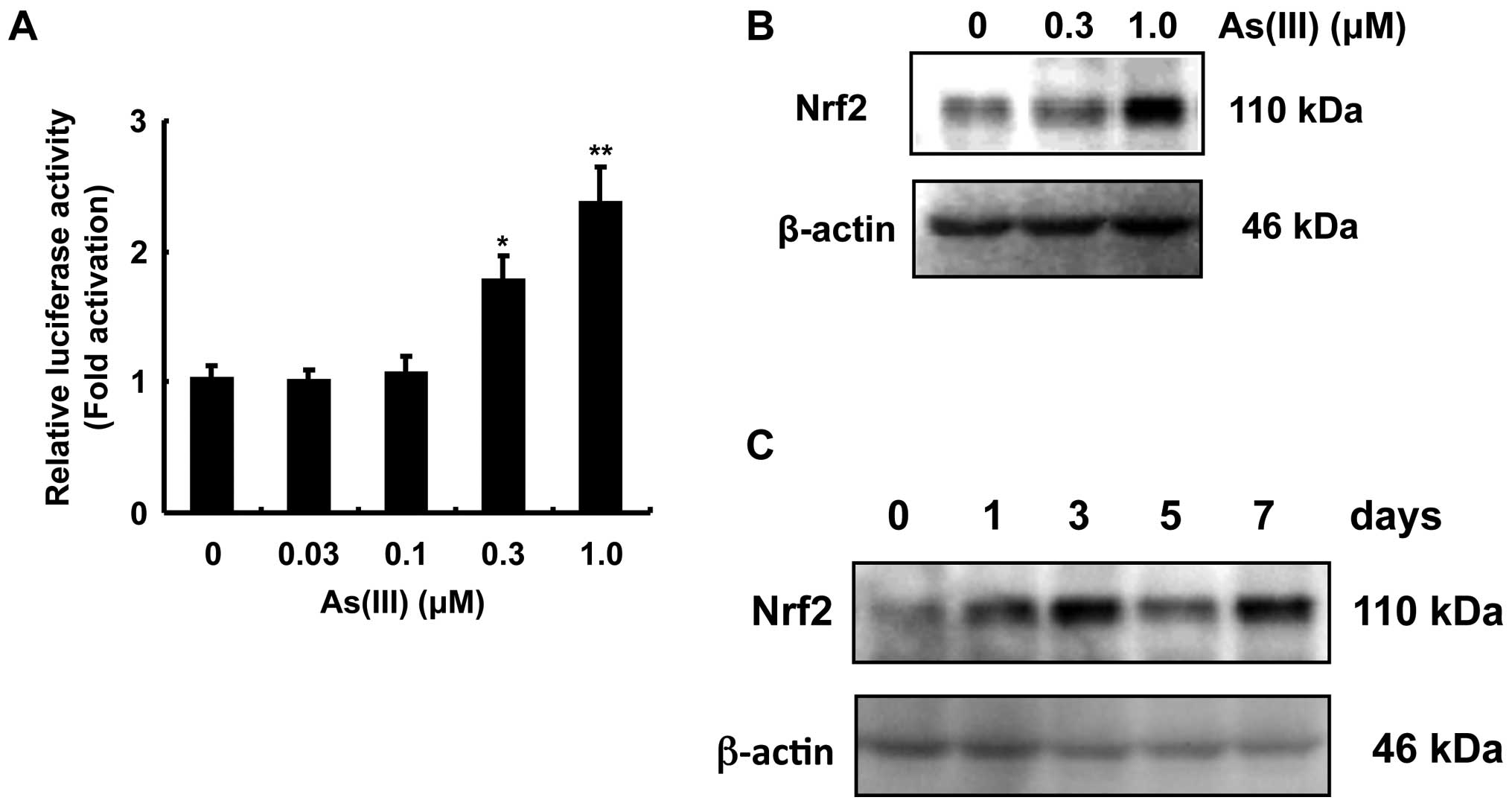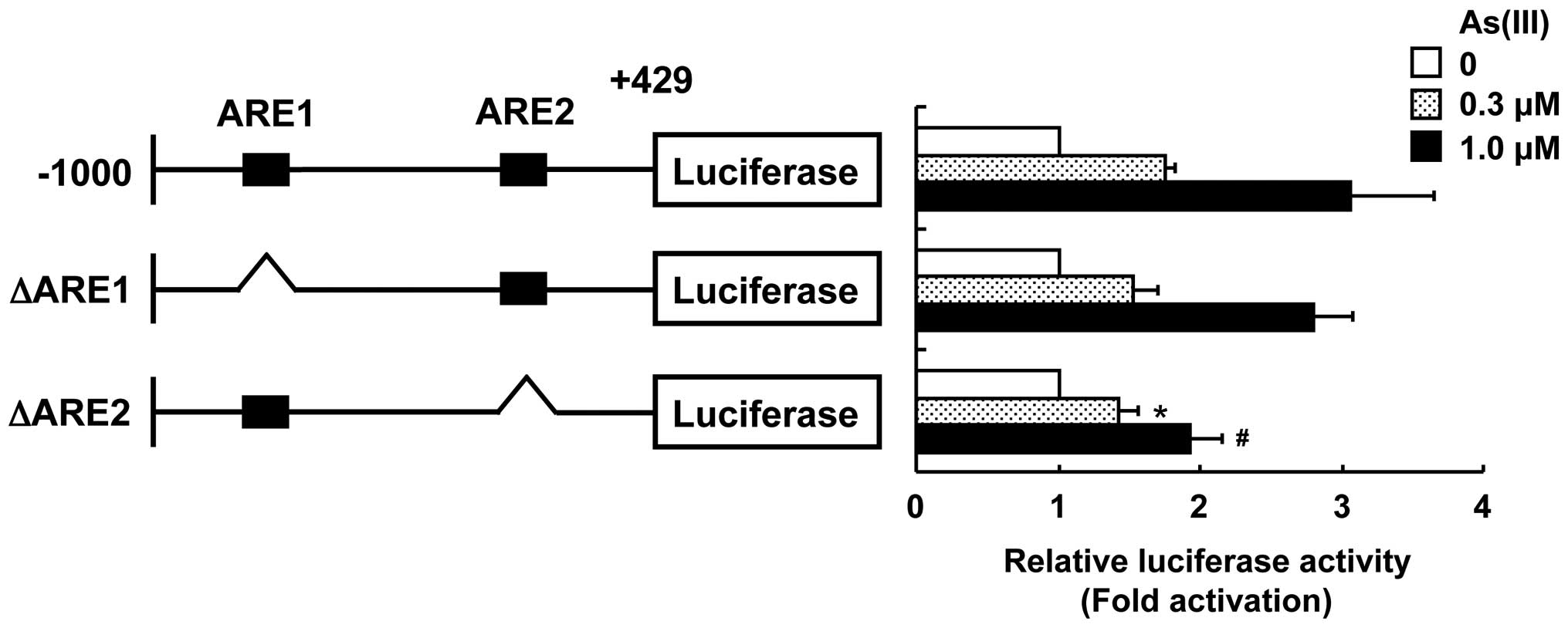|
1
|
Engel RR, Hopenhayn-Rich C, Receveur O and
Smith AH: Vascular effects of chronic arsenic exposure: a review.
Epidemiol Rev. 16:184–209. 1994.PubMed/NCBI
|
|
2
|
Tseng WP, Chu HM, How SW, Fong JM, Lin CS
and Yeh S: Prevalence of skin cancer in an endemic area of chronic
arsenicism in Taiwan. J Natl Cancer Inst. 40:453–463.
1968.PubMed/NCBI
|
|
3
|
Kozul CD, Hampton TH, Davey JC, et al:
Chronic exposure to arsenic in the drinking water alters the
expression of immune response genes in mouse lung. Environ Health
Perspect. 117:1108–1115. 2009. View Article : Google Scholar : PubMed/NCBI
|
|
4
|
Liao WT, Yu CL, Lan CC, et al:
Differential effects of arsenic on cutaneous and systemic immunity:
focusing on CD4+ cell apoptosis in patients with
arsenic-induced Bowen’s disease. Carcinogenesis. 30:1064–1072.
2009. View Article : Google Scholar : PubMed/NCBI
|
|
5
|
Banerjee N, Banerjee S, Sen R, et al:
Chronic arsenic exposure impairs macrophage functions in the
exposed individuals. J Clin Immunol. 29:582–594. 2009. View Article : Google Scholar : PubMed/NCBI
|
|
6
|
Shimizu Y, Fujishiro H, Matsumoto K, Sumi
D, Satoh M and Himeno S: Chronic exposure to arsenite induces
S100A8 and S100A9 expression in rat RBL-2H3 mast cells. J Toxicol
Sci. 36:135–139. 2011. View Article : Google Scholar : PubMed/NCBI
|
|
7
|
Ehrchen JM, Sunderkotter C, Foell D, Vogl
T and Roth J: The endogenous Toll-like receptor 4 agonist
S100A8/S100A9 (calprotectin) as innate amplifier of infection,
autoimmunity, and cancer. J Leukoc Biol. 86:557–566. 2009.
View Article : Google Scholar : PubMed/NCBI
|
|
8
|
Nacken W, Roth J, Sorg C and Kerkhoff C:
S100A9/S100A8: Myeloid representatives of the S100 protein family
as prominent players in innate immunity. Microsc Res Tech.
60:569–580. 2003. View Article : Google Scholar : PubMed/NCBI
|
|
9
|
Kerkhoff C, Nacken W, Benedyk M, Dagher
MC, Sopalla C and Doussiere J: The arachidonic acid-binding protein
S100A8/A9 promotes NADPH oxidase activation by interaction with
p67phox and Rac-2. FASEB J. 19:467–469. 2005.PubMed/NCBI
|
|
10
|
Kerkhoff C, Sorg C, Tandon NN and Nacken
W: Interaction of S100A8/S100A9-arachidonic acid complexes with the
scavenger receptor CD36 may facilitate fatty acid uptake by
endothelial cells. Biochemistry. 40:241–248. 2001. View Article : Google Scholar : PubMed/NCBI
|
|
11
|
Loser K, Vogl T, Voskort M, et al: The
Toll-like receptor 4 ligands Mrp8 and Mrp14 are crucial in the
development of autoreactive CD8+ T cells. Nat Med.
16:713–717. 2010. View
Article : Google Scholar : PubMed/NCBI
|
|
12
|
Itoh K, Tong KI and Yamamoto M: Molecular
mechanism activating Nrf2-Keap1 pathway in regulation of adaptive
response to electrophiles. Free Radic Biol Med. 36:1208–1213. 2004.
View Article : Google Scholar : PubMed/NCBI
|
|
13
|
Aono J, Yanagawa T, Itoh K, et al:
Activation of Nrf2 and accumulation of ubiquitinated A170 by
arsenic in osteoblasts. Biochem Biophys Res Commun. 305:271–277.
2003. View Article : Google Scholar : PubMed/NCBI
|
|
14
|
Kumagai Y and Sumi D: Arsenic: signal
transduction, transcription factor, and biotransformation involved
in cellular response and toxicity. Annu Rev Pharmacol Toxicol.
47:243–262. 2007. View Article : Google Scholar : PubMed/NCBI
|
|
15
|
Fusenig NE and Boukamp P: Multiple stages
and genetic alterations in immortalization, malignant
transformation, and tumor progression of human skin keratinocytes.
Mol Carcinog. 23:144–158. 1998. View Article : Google Scholar : PubMed/NCBI
|
|
16
|
Rossi MR, Masters JR, Park S, et al: The
immortalized UROtsa cell line as a potential cell culture model of
human urothelium. Environ Health Perspect. 109:801–808. 2001.
View Article : Google Scholar : PubMed/NCBI
|
|
17
|
Cheng P, Corzo CA, Luetteke N, et al:
Inhibition of dendritic cell differentiation and accumulation of
myeloid-derived suppressor cells in cancer is regulated by S100A9
protein. J Exp Med. 205:2235–2249. 2008. View Article : Google Scholar : PubMed/NCBI
|
|
18
|
Eue I, Pietz B, Storck J, Klempt M and
Sorg C: Transendothelial migration of 27E10+ human
monocytes. Int Immunol. 12:1593–1604. 2000. View Article : Google Scholar : PubMed/NCBI
|
|
19
|
Kerkhoff C, Hofmann HA, Vormoor J, et al:
Binding of two nuclear complexes to a novel regulatory element
within the human S100A9 promoter drives the S100A9 gene expression.
J Biol Chem. 277:41879–41887. 2002. View Article : Google Scholar : PubMed/NCBI
|
|
20
|
Melkonyan H, Hofmann HA, Nacken W, Sorg C
and Klempt M: The gene encoding the myeloid-related protein 14
(MRP14), a calcium-binding protein expressed in granulocytes and
monocytes, contains a potent enhancer element in the first intron.
J Biol Chem. 273:27026–27032. 1998. View Article : Google Scholar
|
|
21
|
Pi J, Qu W, Reece JM, Kumagai Y and
Waalkes MP: Transcription factor Nrf2 activation by inorganic
arsenic in cultured keratinocytes: involvement of hydrogen
peroxide. Exp Cell Res. 290:234–245. 2003. View Article : Google Scholar : PubMed/NCBI
|
|
22
|
Wang XJ, Sun Z, Chen W, Li Y, Villeneuve
NF and Zhang DD: Activation of Nrf2 by arsenite and
monomethylarsonous acid is independent of Keap1-C151: enhanced
Keap1-Cul3 interaction. Toxicol Appl Pharmacol. 230:383–389. 2008.
View Article : Google Scholar : PubMed/NCBI
|
|
23
|
Wang XJ, Sun Z, Chen W, Eblin KE, Gandolfi
JA and Zhang DD: Nrf2 protects human bladder urothelial cells from
arsenite and monomethylarsonous acid toxicity. Toxicol Appl
Pharmacol. 225:206–213. 2007. View Article : Google Scholar : PubMed/NCBI
|
|
24
|
Lin L, Stringfield TM, Shi X and Chen Y:
Arsenite induces a cell stress-response gene, RTP801, through
reactive oxygen species and transcription factors Elk-1 and
CCAAT/enhancer-binding protein. Biochem J. 392:93–102. 2005.
View Article : Google Scholar : PubMed/NCBI
|
|
25
|
Barchowsky A, Dudek EJ, Treadwell MD and
Wetterhahn KE: Arsenic induces oxidant stress and NF-kappa B
activation in cultured aortic endothelial cells. Free Radic Biol
Med. 21:783–790. 1996. View Article : Google Scholar : PubMed/NCBI
|
|
26
|
Barchowsky A, Roussel RR, Klei LR, et al:
Low levels of arsenic trioxide stimulate proliferative signals in
primary vascular cells without activating stress effector pathways.
Toxicol Appl Pharmacol. 159:65–75. 1999. View Article : Google Scholar
|
|
27
|
Xu K, Yen T and Geczy CL: IL-10
upregulates macrophage expression of the S100 protein S100A8. J
Immunol. 166:6358–6366. 2001. View Article : Google Scholar : PubMed/NCBI
|
|
28
|
Kuwayama A, Kuruto R, Horie N, Takeishi K
and Nozawa R: Appearance of nuclear factors that interact with
genes for myeloid calcium binding proteins (MRP-8 and MRP-14) in
differentiated HL-60 cells. Blood. 81:3116–3121. 1993.PubMed/NCBI
|
|
29
|
Shen SC, Yang LY, Lin HY, Wu CY, Su TH and
Chen YC: Reactive oxygen species-dependent HSP90 protein cleavage
participates in arsenical As(+3)- and MMA(+3)-induced apoptosis
through inhibition of telomerase activity via JNK activation.
Toxicol Appl Pharmacol. 229:239–251. 2008.PubMed/NCBI
|
|
30
|
Smith KR, Klei LR and Barchowsky A:
Arsenite stimulates plasma membrane NADPH oxidase in vascular
endothelial cells. Am J Physiol Lung Cell Mol Physiol.
280:L442–L449. 2001.PubMed/NCBI
|
|
31
|
Benedyk M, Sopalla C, Nacken W, et al:
HaCaT keratinocytes overexpressing the S100 proteins S100A8 and
S100A9 show increased NADPH oxidase and NF-kappaB activities. J
Invest Dermatol. 127:2001–2011. 2007. View Article : Google Scholar : PubMed/NCBI
|














